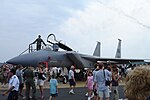Camp Edwards is a United States military training installation located in western Cape Cod in Barnstable County, Massachusetts. It was named after Major General Clarence Edwards, commander of the 26th Division in World War I. The base is currently the home of portions of the 3rd Battalion, 126th Aviation Regiment, of the Massachusetts Army National Guard.
In 1931, the National Guard deemed Camp Devens to be too small to meet their needs and began to look for a new training area, and two years later Cape Cod was identified as having a suitable environment to build a new camp. Camp Edwards was officially dedicated in 1938.
In 1940, the U.S. Army leased Camp Edwards as a training facility as part of its mobilization strategy for World War II. The Army undertook significant construction which helped to expand Camp Edwards from a rustic military post to a small city, overflowing with new GIs. The new plan called for new capacity to house 30,000 soldiers and was completed in just four months. At the peak of the construction, 30 buildings were completed every day. During the war, the camp functioned as a sending off point for troops as well as a training ground for anti-aircraft and amphibious units. By mid-1944 the training centers were relocated to Florida, but the camp remained as a hospital, prisoner-of-war camp, and holding area for AWOL (Absent With Out Leave) soldiers being sent overseas until the end of the war.With the end of the war, Camp Edwards was deactivated. The Air Force took control of nearby Otis Field in 1948, and Otis Air Force Base was born. During the Korean War, the camp was reactivated to train troops. After the war, the camp was again deactivated. The camp was never reactivated for the Vietnam War, but training did go on occasionally.
Camp Edwards was subject to a closure attempt in the 1990s, but survived after objections from the military community. During Hurricane Katrina, the camp was utilized by the Federal Emergency Management Agency, opening up to 2,500 refugees.
Today, the Camp is home to two training centers for National Guard troops. These training centers, which are the only ones in the Northeast other than those at Fort Drum and Fort Dix, are meant to simulate a middle-eastern town.








